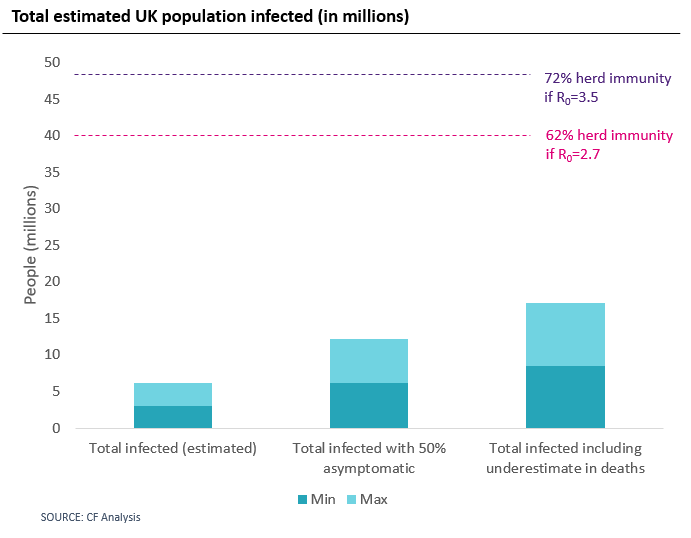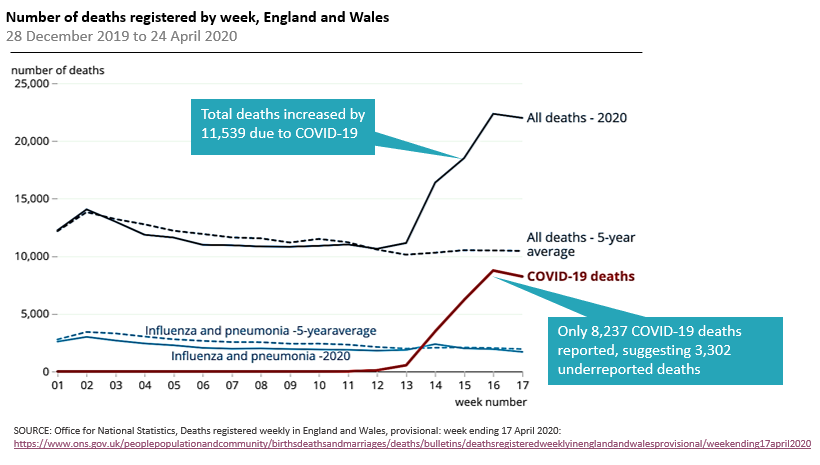In considering a way out of the current COVID-19 crisis, most of the focus has been on finding a successful vaccine. Another way out, however, is achieving herd immunity. Some countries like Sweden have opted not to exert strict restrictions on movement in hopes of letting the virus spread enough to reach herd immunity.1 The effectiveness of this strategy is still controversial as our understanding of the immune response against COVID-19, including how long it lasts, is still limited 2. However, in considering strategies to respond to the outbreak, questions around the possibility of achieving herd immunity against COVID-19 have also been raised in the UK.
The answer to these questions starts with estimating the actual number of infections in the UK, in order to compare that against the percentage of the population required to achieve herd immunity.
However, the challenge in doing so is in the lack of sufficient testing, and a lack of population sampling data. Therefore, the most reliable way to estimate the total number infected is to start from the number of deaths to calculate the expected level of infection. Even deaths, are it seems not that easy to pin down.
We have followed a simple method to arrive at an estimated number of total infected in the UK:
- Look at total number of COVID-19 deaths and revise for those unaccounted for
- Find the implied number of people infected
- Factor in the asymptomatic rate
Figure 1.

Unaccounted deaths
Currently, the UK is the 4th most infected country in the world and has the highest COVID-19 related death count in Europe.
The latest official reports show that weekly deaths have now started to decrease in England and Wales compared to previous weeks (see Figure 2 3). However, in considering the increase in the total number of deaths during the COVID-19 pandemic, there seems to be an underestimation in the numbers reported. For instance, on the week ending April 24th, there were 11,539 more UK weekly deaths than the five-year average (10,458), and only 8,237 of them were reported as COVID deaths. This leaves 3,302 unaccounted deaths on that week alone.
Accounting for these additional would mean a 40% increase in total COVID-related deaths, and consequently in the total number of infections.
Figure 2.

Infection estimates
To date, the UK has had 30,615 total reported COVID deaths (including care home and community deaths).4 With an estimated infection fatality rate of 0.5-1.0% that suggests that 3.1 to 6.1 million people are infected in a UK population of 66 million (or 4.6% to 9.2% of the population).
London deaths are estimated to be 5,414, which suggests that 0.5 to 1.1 million people are infected in a population of 8.9 million (or 6.1% to 12.2% of the population).5
Asymptomatic rate
What about people who are infected but do not display any symptoms, and are therefore not being reported?
Analysis from Iceland, the Diamond Princess cruise ship and the USS Theodore Roosevelt, suggest that up to 50% of the population (especially the young and fit) may be asymptomatic. This would suggest that the above estimate would be doubled, i.e., that 9-18% of the UK have already been infected.
Are we close to herd immunity?
With an estimated virus reproduction number R0 of 2.7-3.5 for COVID-19, 62-72% of the UK population will have to be infected to reach herd immunity. According to the above calculations, even when accounting for people who are asymptomatic and for the underestimate in deaths, the UK is still far from reaching a 62-72% proportion infected. This means that in the absence of a vaccine or therapy, at least 2-3 more infection peaks would be required before herd immunity could be achieved.


